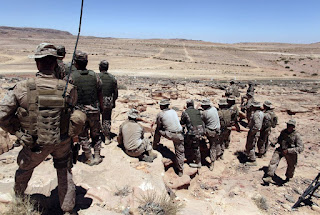
Category: The Green Machine
H&K – The Protest is Over: USMC fields M27 IAR — SHOT Show 2018
H&K had some small announcements for SHOT Show 2018, as well as a big one. First things, first — let’s talk about the rifle.
USMC Shoots H&K
The protest period has ended, which means H&K has officially received the contract for the USMC to replace the M4 carbines.
The H&K model selected is the M27 Infantry Automatic Rifle, a derivative of the famous H&K 416. The M27 features a 16-inch barrel. This is important for the velocity needed to make 5.56 lethal at that range.
It is nice to see the Jarheads getting some nice toys, and some thought put into small arms.
 SPECS:
SPECS:
- Cartridge: 5.56 NATO
- Barrel length: 16 in.
- Weight: 7.9 lbs.
- Gas-operated fully automatic
- Unit price: $3,000
- Overall length: 33 in. – 36.3 in.
- Manufacturer: H&K
H&K Moves to GA
The biggest news is a new H&K factory being built in Georgia, not far from Fort Benning. H&K USA will be designing and building guns directly for the US market in the US now, a huge step.
H&K has always had a small but fanatical following, at least in the US. But all the guns they sold were basically military models changed to meet civilian legal requirements. It was a huge deal the first time H&K built a pistol with a US-style magazine release.
Now, we can look forward to weapons built specific to the US market, our preferred styles are taken into account. This is going to be nothing but positive for H&K, and I can’t wait to see the first one stamped “ Made in Georgia”.
For more information about H&K, click here.
Japanese sergeant major uses body to shield soldiers from volcanic debris, gets killed himself

Fearless hero saved lives in exchange for his own during recent Mt. Kusatsu-Shirane eruption.
Volcanic eruptions in Japan have claimed the lives of people before, sometimes inescapably, and sometimes because they should’ve evacuated instead of staying to take pictures. But other times when Mother Nature rears her terrifying head, there just isn’t enough time to react.
A Japan Ground Self-Defence Force (JGSDF) unit was carrying out ski training on the snowy slopes of Mt. Kusatsu-Shirane in Gunma Prefecture on 23 January when it erupted, spewing out projectile rocks at blinding speeds.
▼ Incredible places of beauty,
snowy mountains can be also extremely deadly.

Sergeant Major Takayuki Izawa and his soldiers immediately took refuge in a small grove of trees while rocks continued raining down from the sky. Seeing that the leaves of trees did little to cushion debris impact, Izawa used his body as a shield to protect his comrades.
A rock that would have hurtled straight into the group struck Izawa squarely in the back instead, critically injuring the sergeant major. It wasn’t long before help arrived, but the wound was grave and he was heard saying that his lungs hurt.
Izawa then suffered cardiac arrest and passed away while being transported to a hospital.
▼ The heartbreaking news, presented here
in this tweet, shocked netizens.
According to his friends, Izawa worked in JGSDF for over 20 years before retiring five years ago to study to be a chiropractic in Aomori Prefecture. It seemed he couldn’t stay away from the duties of protecting his nation for long though, as he decided to re-enlist in 2017.
His teacher described the sergeant major as a very motivated and passionate student, while others thought of him as a person who was always smiling, putting everyone around him at ease.
Japanese netizens were greatly saddened by the passing of a brave hero who placed his comrades’ safety before his:
“I’ll pray for his soul. To the comrades he fought to protect, please live life to your fullest. The Self-Defence Force is the pride of Japan.”
“It’s really noble to sacrifice your life to save others. The JGSDF just lost one of their most outstanding soldiers. I’ll pray for you, may you rest in peace.”
“My heart burns with pride knowing that our people are protected by someone as great as him.”
Soldiers of the JGSDF undergo intense training to protect Japan, a duty that Sergeant Major Takayuki Izawa carried out to the best of his ability. His presence will not only be missed by those he sought to protect, but by everyone he shared his life with.
Source: Livedoor News, Sankei News via Hachima Kiko
Top image: Pakutaso
Insert image: Pakutaso
$35 million – the cost of integration
According to the Daily Caller, the Army spent $35 million to renovate facilities at Fort Benning to accommodate female trainees going through Infantry training. So far, those renovations have produced 22 female graduates, with thirty more in the pipeline. But, hey, what’s a few million bucks when we’re able to say that we’re diverse.
The money was spent on female living facilities and video cameras for security;
As part of the effort to integrate men and women in combat arms, Fort Benning has also had to develop new laundry policies. Before, laundry was open at any time of night. Now, it’s bracketed off at certain times for women.
Initially, Fort Benning officials wanted to place female living quarters on a separate floor, but the women didn’t care for that arrangement. Instead, the women are housed in one of four main sleeping bays.
Newly installed security cameras keep watch on the bay door and the stairs leading to the bay.
That won’t be the end of costs for the Army;
Female recruits have had a higher injury rate than their male counterparts. For example, in the last class, hip stress fractures were an issue for six out of seven females injured in Charlie Company.
From the Associated Press;
And as women drop out, those remaining are moved to new companies to maintain balance within units, said Lt. Col Sam Edwards, commander of 1st Battalion, 19th Infantry regiment. More than 36 percent of Benning’s women have left — about twice the rate of men. Injuries have sidelined other women who plan to restart the training.
Army leaders are closely watching the integration to track injury and performance trends and ensure there are no problems.
“It was a boys club for a long time,” Kendrick said. “You have to be professional.”
Yeah, a boys’ club, that’s what it was. This is only training, it’s not like three or four years of living the infantry life. Show me the stats on the other end – how many women are going to take a another hitch in the infantry after living the life.
So, 35 million smackers to turn out 30 infantry-trained women doesn’t seem cost very effective to me. Especially in these times when training money is scarce.
Here is some more information from Wiki on the Marine Corps newest Toy for Its P.B.I.
(Poor Bloody Infantry)
| M27 Infantry Automatic Rifle | |
|---|---|
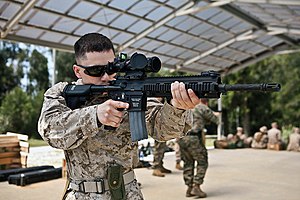
A U.S. Marine armed with an M27 IAR affixed with ACOG Squad Day Optic.
|
|
| Type | Squad automatic weapon Assault rifle Designated marksman rifle |
| Place of origin | Germany |
| Service history | |
| In service | 2010–present |
| Used by | United States Marine Corps |
| Wars | Operation Enduring Freedom |
| Production history | |
| Designer | Heckler & Koch |
| Designed | 2008 |
| Manufacturer | Heckler & Koch |
| Unit cost | US$3,000[1] |
| Produced | 2010–present |
| No. built | 4,153[2] |
| Specifications | |
| Weight | 7.9 lb (3.6 kg) empty 9.8 lb (4.4 kg) loaded weight with sling[3] |
| Length | 36.9 to 33 in (940 to 840 mm) w/ adjustable stock |
| Barrel length | 16.5 in (420 mm) |
| Width | 3.1 in (79 mm) |
| Height | 9.4 in (240 mm) |
|
|
|
| Cartridge | 5.56×45mm NATO |
| Action | Gas-operated short-stroke piston, rotating bolt |
| Rate of fire | Sustained: 36 rpm Cyclic: 700 to 900 rpm |
| Effective firing range | 550 m (point target) 700 m (area target)[4] |
| Maximum firing range | 3,938 yd (3,601 m)[4] |
| Feed system | 30-round STANAG magazine |
| Sights | 3.5x Squad Day Optic, flip-up rear rotary diopter sight and front post |
The M27 Infantry Automatic Rifle(IAR) is a lightweight, magazine-fed 5.56mm, select-fire weapon based on the Heckler & Koch HK416. It is used by the United States Marine Corpsand is intended to enhance an automatic rifleman’s maneuverability. The U.S. Marine Corps initially planned to purchase 6,500 M27s to replace a portion of the M249 light machine guns employed by automatic riflemen within Infantry and Light Armored Reconnaissance Battalions. Approximately 8,000–10,000 M249s will remain in service with the Marine Corps to be used at the discretion of company commanders. The United States Army does not plan to purchase the IAR.[5][6][7] In December 2017, the Marine Corps revealed a decision to equip every Marine in an infantry squad with the M27.[8]
Contents
[hide]
History[edit]
Background[edit]
In 1985, the U.S. Marine Corps adopted the M249 Squad Automatic Weapon, one year after the U.S. Army. Procurement was a service-level decision because the weapon was adopted by the Army with a contract method the Marines could use. While the belt-fed M249 was portable and had a high volume of fire, its relatively heavy weight meant gunners could have trouble keeping up with riflemen.[9]
IAR[edit]
In 1999, a Universal Need Statement was issued for an Infantry Automatic Rifle (IAR). Around 2000, the 1st Marine Division’s 2nd Battalion, 7th Marines Regiment conducted initial, limited IAR trials which confirmed the desirability of a light automatic rifle. Experiences in Iraq and Afghanistan resulted in formal requests for recommendations. The Universal Need Statement spent six years going through the procurement process before an official program was begun and a list of required capabilities was created in early 2005.[9]
The Infantry Automatic Rifle program began on 14 July 2005, when the Marine Corps sent Requests For Information to arms manufacturers. Characteristics desired in the weapon included: portability and maneuverability; similarity in appearance to other rifles in the squad, reducing the likelihood that the gunner will receive special attention from the enemy; facilitation of the gunner’s participation in counter-insurgency operations and capability of maintaining a high volume of fire. An initial requirement for a magazine with a minimum capacity of 100 rounds was dropped in favor of the 30-round STANAG magazine because, at the start of testing, available 100-round magazines were unreliable. Caliber was specified as 5.56×45mm with non-linked ammunition, so as to achieve commonality with existing service rifles.[9][10]
In 2006, contracts were issued to several manufacturers for sample weapons. Fabrique Nationale d’Herstal submitted an IAR variant of the FN SCAR, Heckler & Koch submitted an HK416 variant, and Colt Defense submitted two designs. Companies that attempted to compete but were not accepted as finalists for testing included the Land Warfare Resources Corporation M6A4 IAR,[11][12] Patriot Ordnance Factory,[6] and General Dynamics Armament and Technical Products with the CIS Ultimax 100 MK5 (marketed as the GDATP IAR).[13]
In December 2009, the Heckler & Koch weapon won the competition and entered into a five-month period of final testing.[14][15] In the summer of 2010, it was designated as the M27 Infantry Automatic Rifle,[16] coincidentally sharing a designation with the 2nd Battalion, 7th Marines, who had been testing fully automatic rifles since 2001.[17]

An M27 IAR displayed at the NDIAJoint Armaments Conference in May 2010.
While Marine Corps Systems Command was optimistic about operational testing, former Commandant of the Marine Corps General James T. Conway remained skeptical because of the reduction in firepower at the fireteam-level that would result if the M27 was adopted.[18] He felt that, while more accurate, it was unlikely that the M27 could provide fire-superiority over the M249, a belt-fed LMG. A magazine-fed rifle, requiring frequent reloading, would not be able to sustain the same rate of fire. In a firefight, squad members carrying extra magazines for the M27 might not always be in position to supply them to the gunner. Further, the SAW was already a battle-proven weapon. It was also significant that the Army had chosen not to pursue the IAR concept.[9]
After the Marine Corps Operational Test and Evaluation Activity conducted further testing at MCAGCC Twentynine Palms, Fort McCoy, and Camp Shelby (for dust, cold-weather, and hot-weather conditions, respectively), limited fielding of 458 IARs began to four infantry battalions (one per each Marine Expeditionary Force, one reserve) and one light armored reconnaissance battalion, all of which deployed to Afghanistan in 2011.[19][20]
In May 2011, General James Amos of the U.S. Marine Corps approved the conclusion of the Limited User Evaluation (LUE), and ordered the replacement of the M249 LMG by the M27. Fielding of the approximately 6,500 M27 units was expected to be completed in the summer of 2013, at a cost of $13 million. Each M27 gunner was to be equipped with around twenty-two 30-round magazines of the type currently in use with the M16 and M4 carbineapproximating the combat load of an M249 SAW gunner; although the M27 gunner would not be expected to carry all 22 magazines. The individual combat load would be determined at the unit level and was expected to vary by unit, based on results of evaluations conducted by the four infantry battalions and one light armored reconnaissance battalion that participated in the Limited User Evaluation. Though program officials were aware that switching from the belt-fed M249 would result in a loss of suppressive fire capability, Charles Clark III, of the Marine Corps’ Combat Development and Integration Office, cited the substantially increased accuracy of the M27 as a significant factor in the decision to replace the M249.[21]
Suppressive fire[edit]
The notion that the M27 represents a reduction in suppressive fire has spawned considerable debate between proponents of the M249 SAW within the infantry and those who advocate that a lighter, more maneuverable, and accurate weapon is sufficient to support offensive operations at the squad level. It is debatable, in fact, that program officials actually concede a loss of suppressive fire capabilities, as the only statements of concern over this concept were made by General Conway.
With a SAW, the doctrine of fire suppression is the sound of continuous fire with rounds landing close to the enemy. While the M249’s volume of fire may be greater, it is less accurate. Experienced troops who have dealt with incoming fire are less likely to take cover from incoming rounds if they are not close enough. With an IAR, the doctrine is that lower volume of fire is needed with better accuracy. Fewer rounds need to be used and automatic riflemen can remain in combat longer and in more situations.[9]
Another benefit of the M27 over the M249 is that in many respects it resembles an M4 rifle as used by the rest of the squad. This makes it harder to identify by enemy troops.[9]
Combat reviews[edit]
The IAR was initially fielded in December 2010.[2] 1st Battalion 3rd Marines were deployed to Afghanistan in April 2011 with 84 IARs. Former SAW gunners initially did not like the M27, but appreciated it as time went on. It weighed 9 lb (4 kg) loaded, compared to 22 lb (10 kg) for an M249, which was a significant difference when on 5-hour long missions. Gunners said it was “two weapons in one,” being able to fire single shots accurately out to 800 meters and have fully automatic fire. It also blended in with standard M16-style service rifles, making it difficult for enemy forces to identify the machine gunner. The battalion leadership also saw the M27 as better at preventing collateral damage, as it is more controllable on fully automatic than the M249. Concern of volume of fire loss was made up for through training courses developed in December 2010. With the M249 SAW, the idea of suppression was volume of fire and the sound of the machine gun. With the M27 IAR, the idea of suppression shifts to engaging with precision fire, as it has rifle accuracy at long range and fully automatic fire at short range. Shooters transitioned from long-range precision fire at 700 meters to short-to-medium suppressive fire at 200 meters, both while in the prone position. Some gunners in combat have been used as designated marksmen. An M27 gunner with one aimed shot has the effect of three or four automatic shots from the SAW, and still has the option of a heavier volume with an accurate grouping.[22]
Marines issued with the M27 enjoy its familiarity with the M4-style weapons in service. It is friendlier to troops due to its cleaner, lightweight system having fewer moving parts and jams. IAR gunners consider the rifle-grade accuracy to be a huge improvement over the SAW, despite the loss of sustained firing. With a shrinking budget, the Marine Corps is looking at ways to implement the IAR as a multipurpose weapon. Suggestions included use as an automatic rifle and as a designated marksman rifle,[23] a role where it replaced the Squad Advanced Marksman Rifle.[24] Additionally, the free-floating barrel offers improved accuracy at approximately 2 MOA compared with 4.5 MOA for M16A4 rifles.[25]
Design[edit]
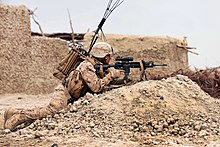
A U.S. Marine armed with an M27 fitted with a Harris bipod and a 3.5x Squad Day Optic covers his team in Afghanistan in March 2012.
The M27 is based on the Heckler & Koch HK416.[26] It features a gas-operated short-stroke piston action with a rotating bolt and a free-floating barrel. The handguard has four MIL-STD-1913 Picatinny rails for use with accessories and optics. The simpler gas-piston rifle system reduces the amount of time it takes to resolve malfunctions on the IAR compared with the M249.[17] Alternate calibers other than 5.56 mm are being considered for the M27.[9]
Use[edit]
The IAR is distributed one per four-man fireteam, three per squad, 28 per company, 84 per infantry battalion, and 72 per Light Armored Reconnaissance Battalion,[27] with 4,476 total for the Marine Corps. The M249 was not completely replaced by the M27, and six of the machine guns are still issued to rifle companies.[28]
In December 2017, the Marines revealed they would be equipping every Marine in an infantry squad with the M27, which would increase the number of rifles procured by at least 11,000. While not every Marine in a battalion will receive the weapon, others outside of squads are also being considered.[8]
Magazine[edit]
The M27 draws ammunition from a standard 30-round STANAG magazine. The improved STANAG magazine with the tan-colored anti-tilt follower is favored over the previous version with the green follower because it can be inserted more easily and the anti-tilt follower can handle high rates of fully automatic fire with less chance of malfunction. While a rifleman normally carries seven 30-round magazines, an IAR gunner has to carry up to 16, and may carry as many as 21, due to its role and fully automatic rate of fire. The magazine well has a flared opening that aids in magazine insertion, but a PMAG 30 GEN M2 magazine cannot be inserted due to the frontal plastic bevel on the PMAG.[4] Because the M27 cannot be fed from the widely used M2 PMAG magazines that M4s or M16 rifles in the squad could take, the Marines banned the polymer PMAG for issue on November 26, 2012 to prevent interchangeability issues.[29] In response, Magpul began the process of arranging verification and official testing for their improved PMAG 30 GEN M3 magazine, which is compatible with both the M27 and M16-series rifles.[30] After Marine Corps testing of the M855A1 Enhanced Performance Round with the M27 showed reliability problems from feeding issues from standard magazines,[31] the PMAG 30 GEN M3 Window, which had better reliability with the EPR, was approved for use by Marines in December 2016 so that M27 gunners who receive M855A1 rounds do not face such issues.[32] Due to its role, high capacity magazines of between 50 and 100 rounds are being explored.[17]
Accessories[edit]
The M27 is essentially an HK416 with accessories required by the Marine Corps.[33] The standard optic is the Trijicon ACOG Squad Day Optic (SDO), officially designated the Sight Unit, SU-258/PVQ Squad Day Optic. It is a 3.5×35 machine gun optic that has a Ruggedized Miniature Reflex (RMR) sight screwed on top for close-quarters engagements under 100 meters. Created for the SAW, the day optic offers slightly less magnification, but longer eye relief than the ACOG Rifle Combat Optic (RCO) on M16s and M4s. The longer relief helps reduce injury risk from recoil.[4][22] It is issued with the Vickers Combat Applications sling and rail sling mounts, AIM Manta Rail Covers, Harris bipod, KAC backup iron sights, a foregrip, and bayonet lug.[34] The M27 initially had a Grip Pod, which is a foregrip with bipod legs inside, but it was later replaced by a separate foregrip and bipod.[9]
In January 2017, a USMC unit deployed with suppressors mounted to their M27 rifles as part of a concept to suppress every weapon in an infantry battalion. Exercises showed that having all weapons suppressed improved squad communication and surprise during engagements; disadvantages included additional heat and weight, increased maintenance, and the greater cost of equipping so many troops with the attachment.[35]
M38 DMR[edit]
In late 2017, the Marine Corps began fielding the M38 designated marksman rifle. Although certain M27s were employed as marksman rifles since 2016, the M38 version outfits the M27 with a Leupold TS-30A2 Mark 4 MR/T 2.5-8x36mm variable power scope, the same optic fitted on the Mk 12 Special Purpose Rifle. The naming of the M38 followed a similar convention to the M27, being named after the 3rd Battalion, 8th Marines unit that tested the rifle out.[36]
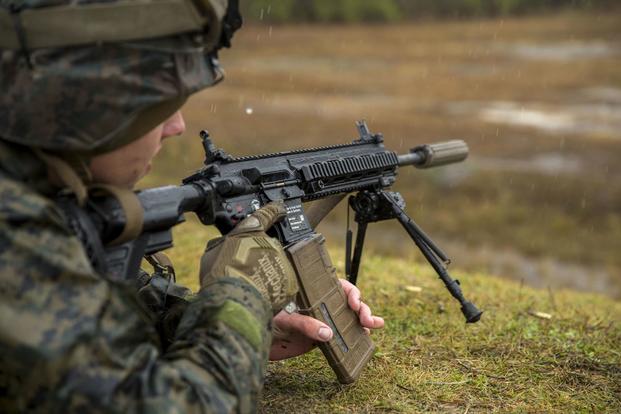
Military.com first reported in November 2016 that the Marine Corps was eyeing the idea of fielding the weapon more broadly within the infantry, and had issued M27s to members of 3rd Battalion, 5th Marines, the service’s experimental infantry battalion, to observe how it improved their effectiveness.
Currently, the M27 is carried by only one member of each infantry fire team: the automatic rifleman.
With the battalion’s deployment to the Pacific at an end, Marine leaders are considering a list of 41 different recommendations generated by the unit, and M27s are at the top of the list.
Related content:
- Marine Corps to Cut Infantry Assaultman Job to Resource Other Roles
- In Wake of Water Deaths, Corps May Add Swim Skills to Cutting Score
- This Logistics Battalion Is the Marine Corps’ Next Experimental Unit
In an interview with Military.com in late December, Commandant Gen. Robert Neller confirmed that a decision had been made to move forward with fielding the M27 more widely within the infantry.
Every Marine in an infantry squad, he said, will receive the high-end rifle. And while not every Marine in a grunt battalion will carry the IAR, others outside of the squad will also be issued one.
“I don’t think mortars and javelin guys need the M27,” Neller said. But, he added, artillery forward observers, fire support teams, and even engineers might be good candidates for the weapon.
“I’m going to wait and see,” he said. “It’s not that much [money].”
The exact number of weapons needed has yet to be determined. In February, the Marine Corps put out a request for information for 11,000 new infantry automatic rifles, enough to equip every squad. But in August, the service published a pre-solicitation for up to 50,800 M27s, to ensure that manufacturer Heckler & Koch was up to the task of meeting an order that large.
Neller has in the past expressed reservations about investing in new weapons and technology for Marine grunts. The IAR, based on the Heckler & Koch HK416, offers a longer effective range and better accuracy than the M4 carbine currently fielded to infantrymen, but it also has come with a steeper price tag: about $3,000 a piece compared to less than $1,000 for the M4.
That may no longer be the case.
Chief Warrant Officer 5 Christian Wade, the gunner for 2nd Marine Division out of Camp Lejeune, North Carolina, told Military.com that competition and economies of scale have pushed the cost of the M27 down significantly.
“The price for that rifle is comparable to what we paid for the M4s the riflemen currently have,” he said. “These companies are competing against each other. And we now have bought the finest infantry rifle for the same price the current infantry rifle is.”
KITTING OUT THE GRUNTS
But with major Marine Corps investments for new rotary-wing and fixed-wing aviation platforms well underway, cost may not be the obstacle it once was for the service. The commandant signaled his plan to invest heavily in the infantry when speaking with deployed Marines during his yearly Christmas tour.
The Marines’ new 5th-generation fighter, the F-35B Joint Strike Fighter, costs roughly $100 million per copy, Neller told troops at one of a dozen town hall-style addresses he gave in the span of seven days in late December.
“I could kit out every grunt in the Marine Corps with the coolest s*** head-to-toe for $100 million,” he said. “And I intend to do that.”
For what else may be coming for the infantry, look to the “Über Squad,” an experiment started this year by Wade.
This summer, the 13-Marine unit from 1st Battalion, 6th Marines, was kitted out with M27s, suppressors, and high-tech Ops-Core helmets borrowed from Marine Corps Special Operations Command that feature built-in hearing protection, but also magnify other sounds to improve situational awareness.
The Marines used light MARSOC body armor and advanced AN/PVS-31A night vision devices. They also got 60-round Magpul drums, allowing them to increase the amount of ammunition they carried.
Wade said that the high-end night vision equipment had proved its worth recently during a nighttime exercise at Marine Corps Air-Ground Combat Center 29 Palms, California.
“That rifle squad moved faster at night than the live fire-safety chaperones,” he said. “[The Über Squad moved too fast for them to keep up because they had better night vision goggles.”
The squad is expected to deploy to Europe sometime this spring to continue testing out gear, but Wade is already working on requirements documents as a starting point to get some of the equipment to every infantry squad.
He said he’s ready to begin writing requirements for a helmet with all the features of special operations gear, including hearing enhancement, communications infrastructure and ear protection.
SUPPRESSORS AND SCOPES
Early efforts to pursue suppressors are also underway.
In September, the Marine Corps published a request for information about a commercially available suppressor that could be used on the M4, the M4A1, and the M27– effectively covering all service weapons used by the infantry. While an early effort, the document instructed prospective suppliers to be ready to supply in large numbers.
“Future procurement quantities of suppressors could span between 18,000 and 194,000,” the RFI reads.
Wade said he’s not yet happy with the suppressor currently in use by the Marine Corps for specialized jobs. He plans to start tests on a flow-through design that reduces signature, he said.
Add to all that one more key piece of gear: a variable power optic that, combined with the M27 and a suppressor, would essentially kit out every Marine in the squad as a designated marksman. Wade said he wants to equip infantry squads from different platoons with various optics and compare their performance to make the case for more powerful equipment.
Currently, Marine grunts carry a 4X power rifle scope; Wade said the idea capability would be a 1-8X power scope.
An RFI published in September described such a scope, the “squad combat optic,” that would work on the M4, M4A1, and M27, and be able to identify and acquire targets at a range of 600 meters or more.
Some of this gear carries with it a sizable price tag. The AN/PVS-31A NVGs, for example, cost about $13,000, compared with about $4,000 for the AN/PVS-14 NVGs currently in use. And all of it isn’t guaranteed to end up with the squad.
But Neller said he’s likely to approve a lot of it, and soon.
“The money to buy all that other stuff, the suppressors, the ear protection enhancement, the different helmets, it’s not a lot of money in the aggregate,” he told Military.com. “So I’m just waiting for them to come back, and I’m ready to say yes.”
And it’s possible all these items are just the start of a full-court press to equip the infantry for future fights.
In an address to Marines with the Black Sea Rotational Force in Romania, Neller hinted at future developments.
“Helmets, [ear protection enhancement], lighter body armor, boots, utilities, everything on the infantry from head to toe is probably going to get changed,” Neller said. “Every Marine’s a rifleman, but not every Marine’s a grunt.”
The infantrymen in the room roared.
— Hope Hodge Seck can be reached at hope.seck@military.com. Follow her on Twitter at @HopeSeck.
Battle Honors & Streamers

Back when I was in Mr. Reagan’s Army. I was able to sneak a peek at our Regimental Colours. I was in the HHT 1/18th US Cavalry

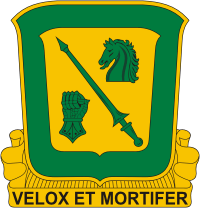
By the way. A Flag goes up & down the pole. A Colour does not according to my Squadron Sgt. Major. A person even our Colonel was slightly afraid of.
Anyways, I was very impressed by them. So I am going to show a few things about them.
United States

Display of streamers from the Flag of the United States Marine Corps
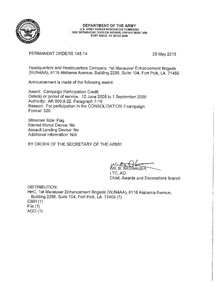
Consolidation II campaign streamer awarded for deployment to Afghanistan from 12 June 2008 to 1 September 2009 for the 1st Maneuver Enhancement Brigade
The United States Army established campaign streamers in 1920, the United States Marine Corps in 1939, the United States Air Force in 1956.
The United States Coast Guard adopted battle streamers in 1968, with the United States Navy following suit in 1971.[1][2]
Many of the practices relative to streamers and their display are similar among the services.
There are, however, differences, particularly regarding the number of streamers and use of embroidered devices.
The Army carries a separate streamer for each important action in all wars in which that service has participated, each embroidered with the name of the action commemorated.
Currently, the Army allows 187[3] streamers, and the Air Force, employing the Army system, carries more than 60.
Unlike the Army-Air Force practice, the Marines and Navy use one ribbon for each war, campaign, or theater of operations.
Specific actions or battles are highlighted by bronze and silver stars embroidered on the ribbon.
The Marine Corps shows more than 40 streamers, the Navy 32, and the Coast Guard uses 43, unadorned by either stars or lettering. Stars on the Marines and Navy streamers follow the practice initiated during the World War II period for ribbons and medals—that is, a bronze service star for each action, and a silver star in lieu of five bronze stars.
The Navy applies stars to appropriate ribbons throughout its history, whereas the Marine Corps uses stars to commemorate service starting from 1900.
The Navy’s Presidential Unit Citation, Navy Unit Commendation, and Meritorious Unit Commendation streamers each carry a red number rather than stars, representing the number of times that the respective award has been conferred upon Navy units.
Generally, streamers are 3 feet (0.91 m) long and 2.75 inches (7.0 cm) wide. Where a medal has been awarded for a particular war or service, the coloring and design of the streamer are the same as the ribbon from which the medal is suspended.
Conflicts and operations for which no medal was issued have ribbons specially designed for use as streamers.
Images
Campaigns
-
the First Barbary Warand the Second Barbary War
-
Operations Against West Indian Pirates
Additionally, units that have been awarded citation or decoration may carry the associated streamer. Foreign awards are last in precedence.
Current US Army policy allows the display of fourrageres and lanyards during ceremonial occasions on the flagstaff of those units authorized.[4]
A foreign unit award medal may also be pinned to the applicable foreign award streamer during ceremonial occasions.[5]
-
Chryssoun Aristion Andrias (Bravery Gold Medal of Greece)
-
Luxembourg War Cross(WWII)
-
Listing of the Campaigns of the U.S. Army
Displayed on the Army Flag- Home
- Unit History
- Organizational History
- Historical Resources
- The Campaigns of the U.S. Army
- Listing of Campaigns
Revolutionary War (16 Streamers)
- Lexington 19 April 1775
- Ticonderoga 10 May 1775
- Boston 17 June 1775-17 March 1776
- Quebec 28 August 1775-3 July 1776
- Charleston 28-29 June 1776; 29 March-12 May 1780
- Long Island 26-29 August 1776
- Trenton 26 December 1776
- Princeton 3 January 1777
- Saratoga 2 July-17 October 1777
- Brandywine 11 September 1777
- Germantown 4 October 1777
- Monmouth 28 June 1778
- Savannah 29 December 1778; 16 September-10 October 1779
- Cowpens 17 January 1781
- Guilford Court House 15 March 1781
- Yorktown 28 September-19 October 1781
War of 1812 (6 Streamers)
- Canada 18 June 1812-17 February 1815
- Chippewa 5 July 1814
- Lundy’s Lane 25 July 1814
- Bladensburg 17-29 August 1814
- McHenry 13 September 1814
- New Orleans 23 September 1814-8 January 1815
Mexican War (10 Streamers)
- Palo Alto 8 May 1846
- Resaca de la Palma 9 May 1846
- Monterey 21 September 1846
- Buena Vista 22-23 February 1847
- Vera Cruz 9-29 March 1847
- Cerro Gordo 17 April 1847
- Contreras 18-20 August 1847
- Churubusco 20 August 1847
- Molino del Rey 8 September 1847
- Chapultepec 13 September 1847
Civil War (25 Streamers)
- Sumter 12-13 April 1861
- Bull Run 16-22 July 1861
- Henry & Donelson 6-16 February 1862
- Mississippi River 6 February 1862-9 July 1863
- Peninsula 17 March-3 August 1862
- Shiloh 6-7 April 1862
- Valley 15 May-17 June 1862
- Manassas 7 August-2 September 1862
- Antietam 3-17 September 1862
- Fredericksburg 9 November-15 December 1862
- Murfreesborough 26 December 1862-4 January 1863
- Chancellorsville 27 April-6 May 1863
- Gettysburg 29 June-3 July 1863
- Vicksburg 29 March-4 July 1863
- Chickamauga 16 August-22 September 1863
- Chattanooga 23-27 November 1863
- Wilderness 4-7 May 1864
- Atlanta 7 May-2 September 1864
- Spotsylvania 8-21 May 1864
- Cold Harbor 22 May-3 June 1864
- Petersburg 4 June 1864-2 April 1865
- Shenandoah 7 August-28 November 1864
- Franklin 17-30 November 1864
- Nashville 1-16 December 1864
- Appomattox 3-9 April 1865
Indian Wars (14 Streamers)
- Miami January 1790-August 1795
- Tippecanoe 21 September-18 November 1811
- Creeks 27 July 1813-August 1814; February 1836-July 1837
- Seminoles 20 November 1817-31 October 1818; 28 December 1835-14 August 1842; 15 December 1855-May 1858
- Black Hawk 26 April-20 September 1832
- Comanches 1867-1875
- Modocs 1872-1873
- Apaches 1873; 1885-1886
- Little Big Horn 1876-1877
- Nez Perces 1877
- Bannocks 1878
- Cheyennes 1878-1879
- Utes September 1879-November 1880
- Pine Ridge November 1890-January 1891
War with Spain (3 Streamers)
- Santiago 22 June-11 July 1898
- Puerto Rico 25 July-13 August 1898
- Manila 31 July-13 August 1898
China Relief Expedition (3 Streamers)
- Tientsin 13 July 1900
- Yang-tsun 6 August 1900
- Peking 14-15 August 1900
Philippine Insurrection (11 Streamers)
- Manila 4 February-17 March 1899
- Iloilo 8-12 February 1899
- Malolos 24 March-16 August 1899
- Laguna de Bay 8-17 April 1899
- San Isidro 12 April-30 May 1899; 15 October-19 November 1899
- Zapote River 13 June 1899
- Cavite 7-13 October 1899; 4 January-9 February 1900
- Tarlac 5-20 November 1899
- San Fabian 6-19 November 1899
- Mindanao 4 July 1902-31 December 1904; 22 October 1905
- Jolo 1-24 May 1905; 6-8 March 1906; 6 August 1906; 11-15 June 1913
World War I (13 Streamers)
- Cambrai 20 November-4 December 1917
- Somme Defensive 21 March-6 April 1918
- Lys 9-27 April 1918
- Aisne 27 May-5 June 1918
- Montdidier-Noyon 9-13 June 1918
- Champagne-Marne 15-18 July 1918
- Aisne-Marne 18 July-6 August 1918
- Somme Offensive 8 August-11 November 1918
- Oise-Aisne 18 August-11 November 1918
- Ypres-Lys 19 August-11 November 1918
- St. Mihiel 12-16 September 1918
- Meuse-Argonne 26 September-11 November 1918
- Vittorio Veneto 24 October-4 November 1918
World War II (38 Streamers)
WWII – American Theater (1 Streamer)
- Antisubmarine 7 December 1941-2 September 1945
WWII – Asiatic-Pacific Theater (21 Streamers)
- Philippine Islands 7 December 1941-10 May 1942
- Burma, 1942 7 December 1941-26 May 1942
- Central Pacific 7 December 1941-6 December 1943
- East Indies 1 January-22 July 1942
- India-Burma 2 April 1942-28 January 1945
- Air Offensive, Japan 17 April 1942-2 September 1945
- Aleutian Islands 3 June 1942-24 August 1943
- China Defensive 4 July 1942-4 May 1945
- Papua 23 July 1942-23 January 1943
- Guadalcanal 7 August 1942-21 February 1943
- New Guinea 24 January 1943-31 December 1944
- Northern Solomons 22 February 1943-21 November 1944
- Eastern Mandates 31 January-14 June 1944
- Bismarck Archipelago 15 December 1943-27 November 1944
- Western Pacific 15 June 1944-2 September 1945
- Leyte 17 October 1944-1 July 1945
- Luzon 15 December 1944-4 July 1945
- Central Burma 29 January-15 July 1945
- Southern Philippines 27 February-4 July 1945
- Ryukyus 26 March-2 July 1945
- China Offensive 5 May-2 September 1945
WWII – European-African-Middle Eastern Theater (16 Streamers)
- Egypt-Libya 11 June 1942-12 February 1943
- Air Offensive, Europe 4 July 1942-5 June 1944
- Algeria-French Morocco 8-11 November 1942
- Tunisia 17 November 1942-13 May 1943
- Sicily 9 July-17 August 1943
- Naples-Foggia 18 August 1943-21 January 1944 (Air); 9 September 1943-21 January 1944 (Ground)
- Anzio 22 January-24 May 1944
- Rome-Arno 22 January-9 September 1944
- Normandy 6 June-24 July 1944
- Northern France 25 July-14 September 1944
- Southern France 15 August-14 September 1944
- Northern Apennines 10 September 1944-4 April 1945
- Rhineland 15 September 1944-21 March 1945
- Ardennes-Alsace 16 December 1944-25 January 1945
- Central Europe 22 March-11 May 1945
- Po Valley 5 April-8 May 1945
Korean War (10 Streamers)
- UN Defensive 27 June-15 September 1950
- UN Offensive 16 September-2 November 1950
- CCF Intervention 3 November 1950-24 January 1951
- First UN Counteroffensive 25 January-21 April 1951
- CCF Spring Offensive 22 April-8 July 1951
- UN Summer-Fall Offensive 9 July-27 November 1951
- Second Korean Winter 28 November 1951-30 April 1952
- Korea, Summer-Fall 1952 1 May-30 November 1952
- Third Korean Winter 1 December 1952-30 April 1953
- Korea, Summer 1953 1 May-27 July 1953
Vietnam War (17 Streamers)
- Advisory 15 March 1962-7 March 1965
- Defense 8 March-24 December 1965
- Counteroffensive 25 December 1965-30 June 1966
- Counteroffensive, Phase II 1 July 1966-31 May 1967
- Counteroffensive, Phase III 1 June 1967-29 January 1968
- Tet Counteroffensive 30 January-1 April 1968
- Counteroffensive, Phase IV 2 April-30 June 1968
- Counteroffensive, Phase V 1 July-1 November 1968
- Counteroffensive, Phase VI 2 November 1968-22 February 1969
- Tet 69/Counteroffensive 23 February-8 June 1969
- Summer-Fall 1969 9 June-31 October 1969
- Winter-Spring 1970 1 November 1969-30 April 1970
- Sanctuary Counteroffensive 1 May-30 June 1970
- Counteroffensive, Phase VII 1 July 1970-31 June 1971
- Consolidation I 1 July-30 November 1971
- Consolidation II 1 December 1971-29 March 1972
- Cease-Fire 30 March 1972-28 January 1973
Armed Forces Expeditions (4 Streamers)
- Dominican Republic 28 April 1965-21 September 1966
- Grenada 23 October-21 November 1983
- Panama 20 December 1989-31 January 1990
- Somalia 5 December 1992-31 March 1995
Southwest Asia (3 Streamers)
- Defense of Saudi Arabia 2 August 1990-16 January 1991
- Liberation and Defense of Kuwait 17 January-11 April 1991
- Cease-Fire 12 April 1991-30 November 1995
Kosovo (2 Streamers)
- Kosovo Air Campaign 24 March – 10 June 1999
- Kosovo Defense Campaign 11 June 1999 – 31 December 2013
War on Terrorism (13 Streamers)
- Global War on Terrorism 11 September 2001 – (Closing date to be determined)
Afghanistan (5 Streamers)
- Liberation of Afghanistan 11 September 2001 – 30 November 2001
- Consolidation I 1 December 2001 – 30 September 2006
- Consolidation II 1 October 2006 -30 November 2009
- Consolidation III 1 December 2009 – 30 June 2011
- Transition I 1 July 2011 – 31 December 2014
- Transition II 1 January 2015 – (Closing date to be determined, not authorized for display)
Iraq (7 Streamers)
- Liberation of Iraq 19 March 2003 – 1 May 2003
- Transition of Iraq 2 May 2003 – 28 June 2004
- Iraqi Governance 29 June 2004 – 15 December 2005
- National Resolution 16 December 2005 – 9 January 2007
- Iraqi Surge 10 January 2007 -31 December 2008
- Iraqi Sovereignty 1 January 2009 – 31 August 2010
- New Dawn 1 September 2010 – 31 December 2011
Also here is something to piss off the SJW Folks!




